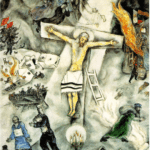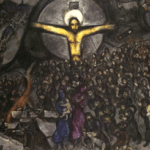Michelangelo’s famous sculpture of Moses – exhibited in the Church of St Peter in Chains in Rome – is one of the most celebrated pieces of High Renaissance art. It depicts a seated Moses nobly holding the tablets of the Law after having descended from Mount Sinai for the second time (Exodus chapter 34). The statue, which was completed in 1515 to adorn the tomb of Pope Julius II, is beloved for many reasons: the sense of impending movement that it captures; the amazingly lifelike appearance of the musculature, beard and hair; and the knowing expression of wisdom on the face of Moses. But above all, what makes this statue famous is the rather odd fact that Moses has two horns on the top of his head. Why is this?
The horns on Moses’ head derive from a mistranslation of Exodus 34:29. In this post I would like to discuss this verse and the ways in which it has been (mis)understood throughout history. Here is the original Masoretic Hebrew text of this verse:
וַיְהִי בְּרֶדֶת מֹשֶׁה מֵהַר סִינַי וּשְׁנֵי לֻחֹת הָעֵדֻת בְּיַד-מֹשֶׁה בְּרִדְתּוֹ מִן-הָהָר וּמֹשֶׁה לֹא-יָדַע כִּי קָרַן עוֹר פָּנָיו בְּדַבְּרוֹ אִתּוֹ
The Hebrew text says that when Moses came down from Mount Sinai “he was not aware that the skin of his face karan (קָרַן) because he had spoken with the Lord.” There are several unusual things going on here. Why is Moses unaware that his face has undergone a change after having descended from Mt Sinai? Why does it say “the skin of his face” as opposed to simply “his face”? What is the meaning of karan? In what follows, I will address the last of these questions.
The Hebrew verb karan (קָרַן) is very rare. It appears only three times in the Bible, all of which are in the very passage which we are examining here (Exodus 34:29,30,35). The verb karan is derived from the noun keren (קֶרֶן) which means “projection” or “horn”. When used in reference to an animal, the word keren always means “horn”. For example, in the story of the Binding of Isaac (Gen 22:13) we read: “And Abraham lifted up his eyes, and looked, and behold behind him a ram caught in the thicket by his horns (קַרְנָיו).” However, when the word keren is used in reference to a human being in the Bible, it has a figurative meaning. For example, in the Prayer of Hannah (1 Sam. 2:1) we read: “my heart exults in the LORD, my horn (קַרְנִי) is exalted in the LORD.” No one imagines that Hannah has a physical horn sticking out of her head. Rather, she is using the word keren to mean “my strength that projects outwards.” So too, when the word keren is applied to God, it certainly means a “ray of light”, and not a “horn”. This is clearly seen in the Prayer of Habakkuk: “His splendor was like the sunrise, rays (קַרְנַיִם) flashed from his hand, where his power was hidden” (Hab. 3:4).
The figurative reading of the noun keren seen above should be similarly applied to the verb karan in Exodus 34. That is to say, we should read “the skin of his face karan” as a metaphorical phrase meaning “his face was radiant” or “the skin of his face shone”. This is what responsible modern translators have written. It is also the way that most ancient readers of the Bible thought, as for example seen in the writings of Paul: “…the Israelites could not look steadily at the face of Moses because of its glory (δόξαν), transitory though it was…” (2 Corinthians 3:7).
However, in medieval Christian Europe a totally literal translation of this verse – “his face was horned” – became the norm. In the 16th century, Roman Catholics read in their Latin Bibles that the face of Moses cornuta esset and assumed that these were the authentic words of Scripture. Michelangelo’s statue of Moses is just one example of a medieval depiction of Moses with these strange horns.
The person at the root of this thorny problem is the famous 4th/5th century Church Father Jerome. Born in Dalmatia, educated in Rome, settled in Bethlehem, Jerome devoted many years of his life to producing an improved Latin translation of the Bible known as the Vulgate. By and large, the Vulgate is a masterpiece of Latin literature which does a marvelous job preserving the meaning of the original Hebrew. But for some reason, Jerome decided to translate the verse in question as follows:
Latin Cumque descenderet Moses de monte Sinai tenebat duas tabulas testimonii et ignorabat quod cornuta esset facies sua ex consortio sermonis Dei.
English And when Moses came down from the Mount Sinai, he held the two tables of the testimony, and he knew not that his face was horned from the conversation of the Lord.
Jerome (345-420) spent the second half of his life writing in monastic seclusion in a cell in Bethlehem. He was a learned and experienced translator, deeply familiar with the Greek translation of the Bible (Septuagint). He employed several Jewish teachers in Palestine to teach him Biblical Hebrew. It is therefore particularly odd that Jerome should have chosen this irresponsibly literal translation of the verb karan. Why did he not follow the figurative direction taken several centuries earlier by the Greek translators in the Septuagint? Here is the LXX of this verse:
Greek ὡς δὲ κατέβαινεν μωυσῆς ἐκ τοῦ ὄρους καὶ αἱ δύο πλάκες ἐπὶ τῶν χειρῶν μωυσῆ καταβαίνοντος δὲ αὐτοῦ ἐκ τοῦ ὄρους μωυσῆς οὐκ ᾔδει ὅτι δεδόξασται ἡ ὄψις τοῦ χρώματος τοῦ προσώπου αὐτοῦ ἐν τῷ λαλεῖν αὐτὸν αὐτῷ
English And when Moses went down from the mountain, the two tablets were in the hands of Moses; then going down from the mountain, Moses did not know that the appearance of the skin of his face was glorified, when God spoke to him.
Today, modern readers of the Bible understand that the Hebrew phrase karan ‘or panav should be read metaphorically to mean: “his face shone” or “his face projected rays of light”. But the damage has already been done. The Vulgate was a tremendously influential book, out of which countless translations into modern languages were produced. Unfortunately, the mistranslation of the verb karan by Jerome had tragic consequences. For centuries, millions of people around the world have wrongly believed that Moses – and in some cases, all Jews – have horns on their heads! Let us hope that the growing interest in reading the Hebrew Bible in its original language will continue to bring about the end of irresponsible and unfounded prejudices.









Second. Notwithstanding your teaching, I think we need to consider the potential consequences if the literal translation has any validity. Probably an exercise in teaching that the other outcomes are so foreign to us endemically, that we can comprehend yet another element and character of the teaching.. valuable?
Well done. Thank you. Your scholarship helps people like me to understand the deeper and more important elements of the teaching. Since your writing style is just right for me, any chance you have written anything about conflicting descriptions of his physical appearance? My less than perfect memory is that Torah contains some brief references as to his physical description..day to today, as a young man..as the different looking prince in pharoah ‘s court? This would help me to understand the conflicts in his young adult life. To commune with his essence and appreciate how he saw the world thru his eyes…it would help me to understand the deeper teachings. Thank you for your article. My mind thanks you.
So, Moses’s horns, symbolizing power & connection with god, are rays of the sun?
Thank you for your text. I wish to use the close-up face of Moses in a boo I am writing, what is the copyright nature of this picture, where does it come from ? Thank you
Very enlightening. Many thanks for your scholarship!